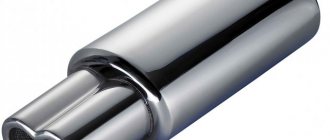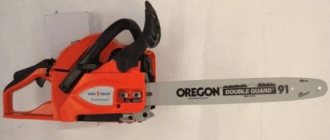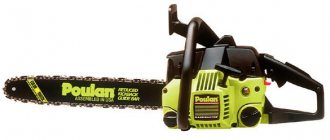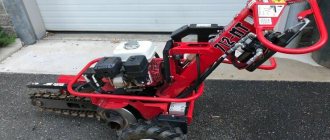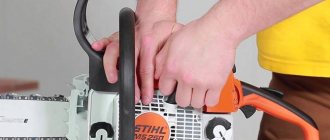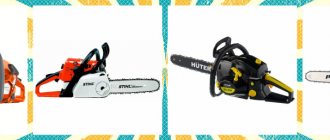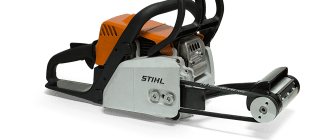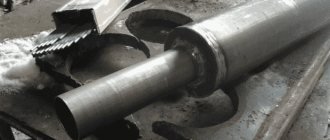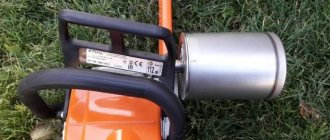Possible inconveniences associated with a quiet muffler
The car will now be quieter, which is what we wanted to achieve, but there may be some disadvantages - an increase in the overall weight of the exhaust system.
Therefore, it is necessary to hang stronger brackets so that the exhaust pipe does not come off on rough roads. There are also cases when rubber shock absorbers are hung. But in fact, a homemade resonator will weigh about 2-3 kg. It is also necessary to test in action how the exhaust system works so that gases exit normally through the exhaust pipe. Therefore, it is necessary to check at higher speeds, then it will be possible to draw the right conclusions. But as a rule, gases will escape through such a resonator without difficulty.
And then in the video there is another way to reduce the sound of the muffler, making a really very quiet exhaust system:
Important Chainsaws "dolmar"
https://youtube.com/watch?v=18SXq0Muiaw
Why does a chainsaw make noise?
There are a few different reasons why chainsaws are so loud. These 3 factors create the most noise:
- engine/motor;
- sawing;
- vibrations.
You've probably already guessed that the engine is the main culprit behind the noise. This is why gas chainsaws are so loud compared to others, as their engines produce the most noise on average.
The cutting process will also add to the noise produced by the chainsaw. A chainsaw with an old chain that is no longer sharp and is not properly lubricated can potentially result in higher noise levels.
Vibrations, although to a much lesser extent, will also increase the overall noise level. One of the reasons electric and cordless chainsaws are much quieter is that they will generate less vibration.
Why do you need a muffler?
Prolonged exposure to extremely loud noises is undoubtedly dangerous and can lead to hearing loss. Chainsaws can be very loud, ranging from 80 to 120 decibels. For comparison, a normal conversation averages about 60 decibels.
The longer and more often you expose yourself to loud noises, and the closer you are to the source, the more damage your hearing will suffer.
Let's look at some data and time frames:
- Sounds up to 70 dB are safe and you can listen to them for extended periods of time.
- Sounds at 85 dB are dangerous if you listen to them for more than 8 hours.
- Sounds at 111 dB are extremely dangerous and can cause hearing loss in less than a minute.
- Sounds around 200 dB are fatal.
Interestingly, the loud noise from chainsaws isn't just dangerous to your ears. Loud noises pose even greater health risks. They can lead to:
- upset stomach;
- high blood pressure;
- increase in heart rate.
After using a chainsaw for a short period of time, you may need to take at least an 18-hour break to allow your hearing to recover.
Check the ignition coil on a chainsaw
If preliminary actions did not help in identifying the cause of the chainsaw malfunction, then it is necessary to check the ignition coil of the saw. Diagnostics is performed in several stages:
- Measure the coil resistance using a multimeter. To do this, you should know the optimal parameters, which are indicated in the operating instructions. However, due to the use of semiconductor elements in the system, if you try to “ring” the coil, the result will be an “Open Circuit” reading. This is fine. A sign of a malfunction is a positive test result. That is, if it was possible to determine the resistance of the coil using a special tool, then it is definitely faulty.
- Check for spark with a special device. This device should be installed in the open circuit located between the spark plug and the high-voltage terminal of the saw's ignition coil. The indicators will be visible on the display. This verification method is more often used in service centers, since the device required for this is expensive, and the costs will not be comparable to the benefits provided.
- Testing the coil using a spark plug, i.e. perform a homemade ignition. To do this, you need to unscrew it, and then attach the body to the cylinder. Now you need to pull the starter and watch for a spark. But this method only gives an approximate result, since the flywheel spins faster due to the unnatural position of the spark plug.
If none of these methods work, or if you need to check in the field, you can proceed as follows:
- Remove the cap from the candle, insert a nail without a head into the core at a distance of 6-7 mm from the cylinder. This must be done as carefully as possible so as not to damage the part.
- Perform the steps required to wind the tool. Now you need to look at the presence of a spark and its color. If there is no malfunction, the spark will be strong and the color will be bright blue.
This method can be used as a last resort and only if there are no electronic components, but it is important to follow the rules:
- Do not completely unscrew the spark plug, as this may cause the flywheel to rotate faster, which is not the correct engine operating mode;
- it must be located at a distance that corresponds to the compression model and dielectric properties of the fuel mixture, so this parameter can be found in the instructions (the value of 6-7 mm is average).
Required materials and tools
In standard cutting products, the exhaust system is made as short as possible. This decision is made to achieve the power required to quickly rotate the chain. In order not to degrade the performance characteristics of equipment and to make it quieter, a thoughtful and comprehensive approach is required.
Making a muffler for a chainsaw with your own hands requires the following tools:
- roulette;
- welding machine;
- metal scissors;
- Bulgarian;
- hammer;
- core;
- marker;
- riveter;
- file;
- electric drill;
- construction hair dryer;
- screwdrivers.
Depending on the specifics of the improvements being made, the following materials may be required:
- sheet stainless steel;
- rivets;
- bolts;
- screws;
- basalt fireproof cord;
- wire;
- solid wood for rollers.
To protect your hands, skin, eyesight and breathing, you should use the following means during work:
- respirator;
- thick clothes;
- assembly gloves;
- glasses;
- construction helmet.
The design of the instrument provides for partial absorption of noise by the body. If there are large gaps in it, they can be sealed with silicone-based mastic. The material will reduce vibration, rattling of plastic and metal.
Why does a chainsaw make noise?
There are a few different reasons why chainsaws are so loud. These 3 factors create the most noise:
- engine/motor;
- sawing;
- vibrations.
You've probably already guessed that the engine is the main culprit behind the noise. This is why gas chainsaws are so loud compared to others, as their engines produce the most noise on average.
The cutting process will also add to the noise produced by the chainsaw. A chainsaw with an old chain that is no longer sharp and is not properly lubricated can potentially result in higher noise levels.
Vibrations, although to a much lesser extent, will also increase the overall noise level. One of the reasons electric and cordless chainsaws are much quieter is that they will generate less vibration.
Why does a chainsaw make noise and why do you need a muffler?
A person can easily tolerate noise of 40 dB. The operation of a chainsaw creates noise pollution of sometimes 120 dB. Its two-stroke, single-cylinder engine produces more annoying sound vibrations than a four-cylinder car engine.
A chainsaw muffler reduces noise levels thanks to:
- redirection of exhaust from combustion of the fuel mixture;
- their crushing;
- changes in gas volumes;
- equalization of gas pulsation.
In addition, it extinguishes sparks, reduces the temperature and speed of the exhaust gas mixture, and diverts it to the side. In this case, there should be a minimum of obstacles to the exit of gases and the entry of air.
How to make the exhaust quieter with your own hands
Upgrading your machine will help make it as quiet as possible. Everyone knows that noise cannot be completely eliminated, but it can be reduced. To create a quiet muffler, different methods are used:
- install another muffler in place of the old one;
- I install an additional resonator;
- install a resonator equipped with an absorbing filler.
Each of the above methods has advantages and disadvantages. If you are upgrading your car's exhaust system yourself to reduce the exhaust sound, you need to have everything you need for the job. For such manipulations you need to have a set of car mechanic tools. You will also undoubtedly need:
- Welding machine. If a choice is possible, then use a semi-automatic or inverter;
- Angle grinder (angle grinder) with a set of discs;
- A workbench equipped with a vice.
Before starting work, you must choose one of the methods for upgrading the exhaust pipe. The first method is to install another factory-made resonator in the area between the first resonator and the muffler. You can also make it yourself.
The first option is the simplest, most popular and accessible. When choosing a method for constructing a low-noise muffler, it is necessary to take into account that the chosen method will lead to various financial expenses. If the owner of the car has the required amount of money, then it is best to purchase a resonator, remove a fragment of the pipe and weld the purchased device into the free space. The second method is undoubtedly much more interesting. The manufacturing technology of such a mechanism must be carefully studied before proceeding with its implementation.
DIY chainsaw muffler
- 1. How to reduce chainsaw noise
- 2. How to make a homemade muffler for a chainsaw
A chainsaw is a very convenient tool to use, and you can prepare firewood and cut the board as needed. The only problem with this is the noise, which cannot be avoided.
A person can easily tolerate noise of no more than 40 dB. Anything higher already hurts the ears and causes a lot of inconvenience. The noise from a chainsaw reaches 70 dB and above, so to say that a chainsaw is very noisy is an understatement. At the same time, a single-cylinder two-stroke chainsaw engine makes much more annoying sounds than a four-cylinder car engine.
How can you reduce the noise from a chainsaw during operation? What attachments to use and how to make a homemade muffler for a chainsaw. This is exactly what will be discussed in this review of the construction magazine samastroyka.ru.
Alternative electrical circuit for electronic ignition for chainsaws.
The easiest to assemble and seemingly intricate and complex circuit will be the circuit that represents the electronic ignition unit of the chainsaw.
This scheme appeared after frequent requests to us for help in repairing chainsaws that had lost the spark discharge on the spark plug produced by the standard electronic unit.
The main reason for the electronic ignition unit to be out of working order is a break in the high-voltage wire or a large gap on the spark plug. Additional negative factors are moisture, damp dust covering the block and, in fact, the use of spark plugs that do not meet the operating and electrical parameters.
We redesigned the standard units to install the most affordable domestic parts on them, which reduces the cost of repairing the unit.
Build process
There are several directions for upgrading a chainsaw with your own hands. With the right approach, a homemade exhaust system will operate effectively without reducing the power of the unit.
The easiest way to get rid of the noise is to use a flexible plastic duct and a container of water. The hose is screwed to the exhaust pipe through heat-insulating gaskets, its other end is lowered into the water and rigidly fixed to the tank.
Gradually cooling and losing speed, the exhaust leaves the engine freely. Contact with air is neutralized by water. To make a similar muffler for a chainsaw, you will need at least 3 m of flexible pipes and a bucket with a capacity of 10-12 liters. This design is suitable for working on a flat, open place without moving around the area. Used for cutting firewood or timber in the courtyard of the house.
A drop in device power and loud sounds at low speeds can be caused by a clogged muffler. Passing through the narrowed hole, the exhaust gases emit a strong roar. In some cases, the instrument makes loud noises that resemble gunshots.
This problem can be solved in the following ways:
- Disassemble the unit in accordance with the attached instructions. Remove the exhaust system, remove carbon deposits from it, wash off solid deposits with solvent or gasoline. Degrease the parts and put them in place. The elements do not need lubrication, since it burns when it comes into contact with exhaust gases.
- Clean the exhaust system mechanically. It should first be dried with a hair dryer, since the sticky substance is difficult to clean off. Carbon deposits are removed using a brush with hard plastic bristles. It is not recommended to use steel fixtures, as they scratch the metal, which leads to accelerated wear of the product.
You can prevent rapid clogging of the muffler by preparing a fuel mixture of high-quality gasoline and oil, which must be mixed in the proportion specified by the manufacturer.
The work is carried out in the following sequence:
- A pattern is made for bending pipes from tin. It is necessary to make two blanks. One should be equal to the exhaust hole. The second is machined with a cross-section 2-2.5 cm larger. For this purpose, it is better to use fine-grained hardwood.
- The stainless steel sheet is cut into pieces of the required length and width. They are wrapped around the rollers. This is done with the help of muscular strength and a hammer. To simplify the process, one edge of the workpiece is rigidly attached to the rollers with nails or screws.
- The edges of the bent pipes are aligned and welded together. On a wide workpiece, the seam is leveled and polished. This is necessary for the safety of the master and to give the product a presentable appearance. Without this, tuning a chainsaw will be incomplete.
- Many holes with a diameter of 3 mm are drilled in a thin pipe. They can be done in any order with an interval of at least 5 mm.
- Metal wool, basalt cord and aluminum wire are wound over the drilled workpiece. The fixation must be tight so that the filler is not blown out by gases under pressure.
- An outer pipe is stretched over the resulting product. They are fastened using bolts or screws. The front facade is welded with a steel washer.
- The finished muffler is attached to the exhaust pipe of the chainsaw. It is better to fix it with rivets.
It doesn’t take much time to make such a device and it’s inexpensive. But the product can last for several years; it only needs to be periodically cleaned to remove accumulated carbon deposits.
Good day, dear readers and subscribers of Andrey Noak’s Blog. Here, recently, my neighbor in the country was cutting down trees on his property and preparing firewood. Naturally I used a chainsaw. Although he purchased not a professional saw, but a household one, it made a lot of noise. While he was working, all the neighbors, including me, were tired of this noise. That’s when the idea came to me, to tell him how to make a muffler for a chainsaw with your own hands.
How to make a muffler for a chainsaw
There are several options for making your own device to reduce noise pollution.
There are simple noise reduction techniques, such as placing steel wool in the muffler. The method works, but the engine power is slightly reduced.
Another simple recommendation on how to make the operation of a chainsaw quieter: put a hose on the exhaust hole and lower it into a bucket of water. To do this, unscrew 3 bolts from the sound-damping saw cube to remove the plug. A homemade flange (cut from roofing iron) is inserted into the freed space and secured to the same 3 bolts. A rubber hose about 3 m long is put on the flange, the other end of which is immersed in water.
Disadvantages of this method:
- being tied to a bucket of water reduces the worker’s mobility;
- rubber hoses burn out quickly.
It is better if the flexible hose has a metal sheath - this will prevent its rapid deterioration. The bucket can be replaced with a plastic canister.
You can make a muffler for a chainsaw with your own hands from tin sheets. You need to bend two pipes from them. One should correspond in diameter to the hole for the exhaust discharge of the saw, and the other should be 2.5 cm wider. Many holes with a diameter of 3 mm are drilled in a narrow pipe. They can be positioned as desired, but the distance between them must be at least 5 mm.
Metal wool, basalt cord and aluminum wire are wound onto the resulting perforated pipe. The winding is done tightly, otherwise the exhaust under pressure will blow it out. A wide pipe is put on top and connected to the inner one with bolts. The end is welded with a steel washer. The resulting additional muffler is placed on the standard muffler and secured with rivets.
Do it yourself
In order to save money and time spent searching for the right workshops, I advise you to make a muffler at home. It's not as difficult as it seems at first glance.
All you need is a regular 1mm stainless steel sheet, an iron tube with a smaller diameter than the muffler, stainless steel wool, basalt fiber and a little patience.
Sequence of work:
We take a sheet of steel and wrap it around the rollers, in the end we get a round tube, but you will definitely need an oval-shaped pipe. To do this, use welding to heat and then press down the tube, you should get an oval shape; If you have a ready-made pipe of a suitable diameter, then this is good, if not, then you need to make it using a welding machine. To do this, take a metal sheet, mark the required dimensions and cut it by welding. Then we make a pipe, the seam should be thin and without bumps; When you have a finished pipe, you need to make as many holes in it as possible, and you can make holes either chaotically or in a strict order, it doesn’t matter at all; Next, we take the stainless steel prepared in advance and begin to wrap the outside of the pipe
This is necessary to prevent the muffler casing from blowing out; Then we wrap basalt fiber over the stainless wool (this is the most suitable material) and so that it all does not slip, we fasten it with wire, which should be thin and at the same time strong; We insert the wrapped pipe into the future apparatus and rub it all down with sandpaper, paying special attention to the seams and joints so that they do not stick out too much; When you have done all this, the resulting unit must be attached to the chainsaw as tightly as possible so that it does not fly off at the right moment.
Such a homemade device, if done correctly, will serve for a long time and will significantly reduce engine noise; it works well on Druzhba chainsaws. Another advantage of a homemade muffler is that it will cost you a meager amount. It will only cost you time, but it's worth it.
You can also use this version of the muffler: install partitions in the pipe, which is located in the muffler, and thereby reduce the noise level of the engine. This is explained by the fact that the noise itself is a strong vibration of air, which comes out of the muffler at great speed.
In order to reduce operating noise, it is enough just to drill holes in the pipe and insert partitions into them at equal distances. There will be many divisions and the gas will gradually come out, while the pressure and noise will decrease. Accordingly, the speed of gas movement will decrease, which will lead to a decrease in noise.
If you want to make the gases leave the cylinders faster, thereby reducing the engine effort so that the saw’s performance increases, remember that the noise will be several times greater.
In order to achieve this, you need a direct-flow muffler, which can be made from a pipe according to the sketches of an old muffler, unscrewing and subsequently using all the bolts and nuts.
I advise you to choose a steel pipe, then the muffler will last longer. If there is no suitable steel pipe, then you need to make one using a steel sheet. Using a welding machine, you can make a tube of the desired diameter and size.
Everything is already provided by the factory, everything should work as one whole, and if you try to change anything yourself, including improving the muffler, without any drawings, then it is quite difficult and not everyone can succeed.
For chainsaws such as Shtil 180, it is better to buy a native muffler, which you can change yourself without any problems.
Therefore, if you have certain knowledge and good ingenuity, then you should try to make an additional muffler yourself, thereby saving money and perhaps you will be able to make a device that will actually make the chainsaw work much quieter and you will not have to constantly quarrel with neighbors or others you people.
This is interesting: How to independently remove the drive sprocket from a chainsaw and replace it with a new one - we explain all the nuances
Why does a chainsaw make noise?
All chainsaws have only one significant drawback - noise during operation, which in some places (dachas, garden plots) bothers and irritates many people. If the noise from a running saw makes it difficult to concentrate, then another option is headphones that suppress the noise. But everyone around you won’t wear headphones while someone else is making noise.
A clogged or improperly repaired muffler is the reason why the engine constantly stalls or does not start at all.
It happens that a chainsaw works normally at low speeds, but as soon as you add gas, it immediately sneezes and stalls. The reason, as a rule, is that the exhaust cannot pass through the muffler clogged with smoke and is forced to move in the opposite direction. To do this, it is enough to remove it and clean it, if of course it is disassembled, if not, then you will have to dry it with hot air using a hairdryer.
The main reason for muffler contamination is an excess amount of oil, which is diluted with gasoline and, as a result, settles on its walls.
If you decide to clean a non-removable muffler yourself, keep in mind that you cannot do it dry using the same hair dryer, since hazardous substances are extremely harmful to health.
Although most chainsaw manufacturers try to muffle engine noise as much as possible, this does not lead to anything good and primarily affects the power of the device.
Professional chainsaws, for example Husqvarna, cannot work quietly at all, since the power and speed are very high, which leads to a lot of noise. Trying to muffle the roar of the engine on your own while maintaining high performance is extremely difficult. But there are people who use an ordinary bucket of water and a plastic tube, lower one end into the water, and screw the other end to the exhaust pipe. Such actions are effective; the sound of the engine becomes quieter.
How to make a chainsaw silent with your own hands
The question of how to make a chainsaw silent with your own hands is asked by almost every owner of a private house or summer cottage. A tool at high speeds creates a loud noise that travels hundreds of meters. Loud sounds irritate the neighbors, and the master himself gets tired of them. By understanding the nature of this phenomenon, you can make the chainsaw quieter, spending a minimum of time and money. The noise occurs when gasoline explodes in the cylinders and when exhaust gases come into contact with air. Partial elimination of these factors leads to noise reduction.
How to reduce chainsaw noise
The operation of a chainsaw is accompanied by the exhaust of gases and loud noise. You can reduce noise using simple methods or using a homemade muffler, the design of which will be discussed below.
To reduce noise, you can place a small steel wool in the factory muffler of a chainsaw. The noise level will decrease, and with it the power of the gas-powered tool. For this reason, this method of reducing chainsaw noise is not suitable for anyone.
By the way, a faulty or dirty chainsaw muffler is also the reason why the noise level increases sharply.
In addition, due to a heavily dirty muffler, the chainsaw may stall all the time or even refuse to start.
In this case, it will be enough to remove the chainsaw muffler, disassemble it, and thoroughly clean the inside of carbon deposits. As a rule, in most cases, the reason for its strong formation is the disturbed proportions of gasoline and oil. In this case, more oil is added to gasoline than is necessary.
The second way to reduce noise is to install another muffler, if, of course, it takes its rightful place. You can even use a regular spray bottle with a built-in metal tube inside. In this case, the impact sound when operating the chainsaw will almost completely disappear.
How to make a muffler for a chainsaw with your own hands
To reduce the noise from a chainsaw, you can try making and installing a muffler on it yourself. To do this you will need:
- 1 mm stainless steel;
- a piece of metal wool;
- Bulgarian;
- pliers;
- screwdriver and drills.
What should be done:
- Make 2 tubes from stainless steel. The first diameter must be made so that it fits into the factory muffler. And the second is a couple of centimeters larger than the first.
- Drill holes in the first tube in any order, but with a distance of at least 5 mm from each other.
- Wrap the first pipe tightly with metal wool so that exhaust gases cannot destroy the constructed structure.
- Place the second tube onto the perforated first tube. To ensure they are well secured, insert self-tapping screws.
- At the end, weld the end of the steel washer for a tight seal.
Such a homemade muffler will reduce the noise from a chainsaw by an average of 25-35%. Of course, you can use other methods of reducing the volume of a chainsaw, both homemade and purchased, but in practice they are not as effective as a homemade steel muffler.
DIY repair
When the above measures do not eliminate the problem, the reasons may be as follows. The electronic ignition unit has failed. All elements of this unit are sealed (filled with compound) and cannot be repaired. The entire unit needs to be replaced.
The cam (contact) ignition system of the Druzhba chainsaw is repairable. There are several reasons for its failure:
- The textolite insulator of the moving contact of the breaker was pierced to ground. Replaces with a working one without any options.
- The moving and fixed contacts of the breaker (cams) were burnt. Clean with a fine file or emery until the surfaces are smoothly adjacent to each other. They change when completely burned out.
- The capacitor is designed to protect contacts from burnout. It rarely fails and does not directly affect the formation of a spark. When diagnosing, it is simply ignored.
- Interturn short circuit, break in the secondary high-voltage turns of a coil with a thin wire.
Why does the spark plug on a chainsaw flood?
In most cases, the cause of a flooded spark plug is a breakdown or clogging of the carburetor. To disassemble, inspect and wash it, the fuel assembly will need to be removed.
To do this you need:
- Unscrew the 3 metal screws and remove the protective plastic cover;
- Carefully remove the upper foam part of the air filter. In this case, you need to inspect the filter element and make sure that there is no need to wash or replace it;
- Remove the fuel hose, being careful not to tear or bend it;
- Remove the drive rod;
- Carefully disconnect the gas supply pipe and the end of the standard cable.
Which to choose
The direct-flow muffling system can be attached directly to the factory saw muffling element. The noise is noticeably reduced: sound damping ensures a narrowing into the funnel of the internal cross-section. However, being large, the structure can prevent free operation.
A threaded muffler for a chainsaw is also attached to the original one. It is small, has an inlet tube with holes that are separated by a helical partition. The exhaust gases entering the pipe exit through holes whose diameters are not the same. This ensures fragmentation of the exhaust force and dampening of sound.
Industrially manufactured silencers meet all safety requirements.
In two-stroke engines, and most chainsaws are equipped with such, the silencer is part of the engine, since a certain portion of the working mixture, after being dumped, again enters the cylinder. Therefore, it must be taken into account that any intervention into the mechanism in order to make operation quieter creates the risk of overheating the system or reducing its power.
Fuel system malfunctions
The main sign of a malfunction in the Shtilev fuel system is that no fuel is supplied to the engine cylinder. Most likely, the problem is in the fuel hose or the condition of the membrane. If they are intact and there is no blockage downwards, the reasons should be sought in a clogged breather or special filter.
If the fuel is supplied by spitting, the stream is weak, most likely the breather is clogged. It must be carefully cleaned with a sharp nail or needle.
In rare cases, fuel does not enter the cylinder correctly due to clogged carburetor passages. It also needs to be cleaned mechanically with a thin screwdriver or wood chips.
How to make a quiet muffler on a car - tuning the silence
Only a small part of car enthusiasts would like to have a loud sports exhaust on their car. The vast majority of drivers, on the contrary, are puzzled by the question of how to make a quiet muffler.
Driving can be comfortable only if as little extraneous sounds as possible enter the cabin. The muffler creates its own background noise, which can be significantly reduced.
The effect of this cannot be ignored.
Basic ways to make a muffler quieter
Before you begin upgrading your exhaust system, you should understand the nature of the increased exhaust sound.
With each working stroke of the piston, a micro-explosion occurs in the combustion chamber of the engine cylinder, which is accompanied by a significant sharp expansion of gases.
Naturally, a kind of blast wave, after it has done its job and moved the piston down, rushes through the exhaust system with the opening of the exhaust valve.
Thus, the nature of exhaust system noise is twofold:
- sound from expansion of gases;
- noise from vibration of exhaust system elements.
As you know, the main way to combat noise is to increase the weight of the elements. The thicker the metal, the less vibration and, accordingly, noise. That is why the exhaust manifold, which is the first to absorb hot gases from the cylinder head, is made so massive.
Many car enthusiasts who had the opportunity to compare the weight of the exhaust pipe of a domestic car and a foreign one noted that the exhaust system parts of foreign cars are much heavier. This is why “our” cars are less comfortable in sound and noise comparisons.
Special elements are designed to reduce the speed of gas movement in the exhaust pipe: resonators and mufflers. First in line is the resonator.
In the muffler labyrinth system, the exhaust gases finally lose their energy and are dissipated. A real quiet muffler on a foreign car is quite heavy and has several separate housings.
Do-it-yourself quiet muffler, video:
Making a quiet muffler with your own hands
When starting to modernize the exhaust system in order to reduce exhaust sound, you should be prepared technically and financially. For work you will need a full set of car mechanic tools. In addition, you will definitely need:
- welding machine (preferably semi-automatic or inverter);
- angle grinder with a set of discs;
- a workbench equipped with a vice.
One of the most affordable ways to get a quiet muffler in the average garage is to include an additional resonator in the existing exhaust system.
https://youtube.com/watch?v=-fSsYErK6PY
There are also two options for upgrading the exhaust system: installing an additional factory-made resonator in the area between the main resonator and the muffler, or making the device yourself.
When considering how to make a muffler quieter, you should keep in mind that either option may entail different costs.
If the car enthusiast is not limited by budget, then you can safely buy a new resonator, cut out part of the pipe and weld it into the free space.
The second method turns out to be more exciting and should be described in more detail.
The manufacturing technology of an additional resonator consists of the following stages:
- manufacturing a body (barrel) from a piece of thin-walled steel pipe or sheet steel in the form of two halves;
- making holes in a section of the exhaust system pipe corresponding to the length of the body behind the main resonator;
- connecting the body halves on a pipe with holes and scalding;
- laying basalt mineral wool into the cavity of the new body;
- welding of the end parts of the resonator.
Finally, the welds should be processed, the new resonator should be cleaned and degreased, and if possible, painted with heat-resistant paint.
, what is an exhaust manifold and resonator?
Additional problems of a quiet car
Once the question of how to make a quiet muffler has been resolved, some problem areas become apparent. First of all, it should be remembered that any of the methods for producing a “quiet” exhaust system will certainly lead to an increase in the weight of the structure.
This, in turn, obliges the car owner to take additional measures to strengthen the brackets and rubber shock absorbers.
Another point to consider is the change in the balance of air entering the engine and exhaust gases.
After upgrading the exhaust system, it is imperative to test the operation of the engine in different modes and make additional adjustments to the fuel supply and air filtration system.
How to Make a Chainsaw Quieter
Is it possible to make this engine quiet? A customer comes to the store to return a chainsaw product. what complaints? Yes, in the annotation he writes that it cuts 4 cubes of firewood in an hour, but I can’t get more than 3, let’s check in a minute (starts it up) wow, why is it whirring for you? There are two motors from chainsaws, both scream incredibly loud, I started experimenting with one of them and made a silencer. but it starts now. The shock sound has disappeared, the exhaust sound has become quieter, but it seems like the engine itself is still making a decent noise. Quiet muffler for chainsaw. How to make a muffler quieter. How to make an exhaust pipe for a chainsaw - Lyons. Muffler for chainsaw video - Mufflers - Spare parts for chainsaws and trimmers. Content. A chainsaw is a universal tool, the scope of which is very wide. Due to the special importance of this kind of equipment, modern manufacturers offer customers a wide selection of different models, not only How to make a muffler for a chainsaw at home. Have a nice day, dear readers and subscribers of Andrey Noak’s Blog. Make a device that will really make the chainsaw work much quieter and you won’t have to constantly quarrel with How to make emission quieter on a chainsaw? It works well. There is an Alpina and a Chinese one, a patriot or something. The Chinese one has just two holes with complex geometry. What can be done to make it work more quietly? how to make a Stihl chainsaw 100% silent | Topic creator: Igor. It is necessary to cut down several trees in the quiet season so that no one sees or hears. Maybe someone knows how to make a plug for the calm without noise and consequences. We will talk further about what you can make from a chainsaw with your own hands. Features of creating a motor drill from a gasoline saw. In order to make a motor drill with your own hands from a chainsaw, first you need to adjust the rotation speed of the motor. How to make the ejection quieter on a chainsaw. VLOGVlog muffler for chainsaw, BLON. Chainsaws already have mufflers. How to make a muffler for a chainsaw. Make your chainsaw quieter. mastercity forum.
Tell me, how to make this muffler for a chainsaw? Then you will need to weld shells into it to dull the operation of the chainsaw and make it work more quietly. Quiet chainsaw. How to make a quiet muffler for a Ural chainsaw - Enote.ru. make a chainsaw quieter - photo- Mastergrad Forum. How to make a muffler for a chainsaw.
Important Design of wheeled excavators, loaders with hydraulic hammers
Product reserve
Electric trimmer FSE 81 AutoCut C6-2 is a fairly powerful tool with a soft anti-vibration handle, electronic speed control and motor overload protection. The device is ideal for homeowners with large lawn areas. The device is used for lawn care and mowing grass thickets in small areas, cutting near curbs and clearing areas around trees, near paths and stairs. The 1000 W electric motor successfully replaces the gasoline engine and overall the result is a well-balanced tool. A flexible shaft is used to drive the mowing head. The loop handle is height adjustable to ensure user comfort. The unit is characterized by low noise level and environmental friendliness.
Features and benefits of FSE 81:
- Power
- Soft anti-vibration handle
- Electronic speed control
- Motor overload protection
- Flexible shaft
- Height-adjustable loop handle
- Convenience and comfort
- Low noise level
- Environmental friendliness
- AutoCut C mowing head
- Support wheel
Equipment
The circular handle of brush cutters and brush cutters is needed for working in tight spaces, for example, when mowing between bushes (see illustration).
For your safety, safety glasses are included as standard. They are well ventilated and have wide side protection (see illustration).
The soft handle absorbs some of the vibration and is extremely comfortable to grip.
This strain relief device for the network cable prevents the plug connector from being accidentally disconnected when the cable is pulled.
The support wheel protects tree bark and plants because the cutting thread does not extend beyond the adjustable wheel.
If you find an error or inaccuracy in the text or product description, highlight it and press Shift+Enter.
Muffler for STIHL chainsaw
The video shows the work of a calm with a homemade muffler, which actually reduces engine noise by more than 50% of the order.
How to make a homemade muffler. The operation of the engine is judged by the noise of the gases, and it went when 2 years ago I made a copy of the Yak-50, and the goal was not to get a quiet one. They made the auger 20 revolutions and put it in the muffler pipe. The sound did not become quieter, but only changed. Roared on one note, on the letter: Sh-Sh-Sh-Sh-Sh-Sh-Sh! Electric saws probably don’t roll, because... We’ve already bought a bunch of chainsaws, but it’s also expensive to buy an electric one. Bosch AKE 30 LI cordless chainsaw. Quiet muffler for chainsaw. How to make a chainsaw » similar videos how to make. Somehow it turned out that the saw was not so expensive on sale. Cordless chain saw CTS CS from OREGON. Silent operation without soot and wires. How to make a silencer for a 2-stroke engine with their own hands. Construction, repairs with your own hands. How to make a chainsaw work silently. Repairing a chainsaw with your own hands A chainsaw, even if one wants to, cannot be classified as a complex device. Nevertheless, repairing a chainsaw can take a lot of time. The “grinder” attachment on a chainsaw performs such operations as cutting metal and stone, grinding the surface, and others. While a dedicated engine is very expensive, a boat engine made from a chainsaw is an excellent budget solution. How to start a chainsaw - a couple of the most popular methods. Disassembling the PARTNER 352 chainsaw. Airplane made from a chainsaw. Test chainsaw muffler. How to make a band saw PART - 1. That’s where the idea came to me, to tell him how to make a muffler for a chainsaw with your own hands. If you are smart, the same Ural saw can be made to work much quieter and this will not affect its performance in any way. There is an idea - to adapt a muffler from a moped to a chainsaw. What do you think? Has anyone done this? Once I had to quietly kill a couple of oak trees. It took a long time with two handles, so we decided to modernize the calm. Homemade muffler for chainsaw. Video; market make a chainsaw quieter make it quieter like an air compressor hose with. Loaded. I use the chainsaw as a boat engine and therefore turned it off. In this video I will show how to simply upgrade a chainsaw, make it safe for hellish pranks. How to make a chainsaw as quiet as possible, and at the same time the loss of power is up to 15-20? So that trees can be felled without burning at night. It will be environmentally friendly, quiet and healthy! In my opinion, if your soul can’t stand the exhaust, there are two options: take a break and eat a Twix or switch to electric. Others: how to make a silent muffler for a chainsaw yourself, homemade products for a car with your own hands, a flame arrester instead of a catalyst for a Ford, a metal mesh in the forward flow, removing the catalyst for a VAZ 2114, a resonator for a Ford explorer 1991 How to make a chainsaw from To make such a saw, you will need: Lemonade Shikhan , rope, lighter, awl, stationery. knife. like How to make the exhaust quieter at idle so as not to disturb the neighbors) AstalavistA inD 3 year. make a chainsaw quieter - photo - Mastergrad Forum. Do-it-yourself quiet exhaust of VAZ 2109 - Raum Profi. How to make a quiet muffler for a chainsaw video - Mosstroyservice. Silent? How to make a chainsaw » similar videos on how to make a chainsaw. But how to make it yourself? How to make the exhaust quieter on a chainsaw? What can be done to make it work more quietly? Therefore, manufacturers around the world are creating more and more models with high power and light weight. Let's talk further in this article about how to make a muffler for a chainsaw. And what to do if you need a powerful and at the same time quiet model for working on a personal plot or when building a log house?
make a chainsaw quieter
I need a specialist who will make a muffler for calm conditions. I am engaged in the production of wooden houses and when 10-12 saws are working it is a disaster. There are residential buildings 100 meters away and I’m afraid that the residents will soon dislike me, to put it mildly. If anyone can make it, I'll buy it.
zhora-spb wrote: I am engaged in the production of wooden houses and when 10-12 saws are working it is a disaster.
Have you thought about electric saws?
masters say that a gas tool has some kind of impact, but in general it doesn’t work
zhora-spb wrote: masters say that a gas tool has some kind of impact,
zhora-spb wrote: in general they sold it, it doesn’t work out
That does not work?
zhora-spb wrote: masters say that a gas tool has some kind of impact
But there’s no electricity or something?
Install a sound-reflecting fence, you can even make a mobile version, but with two-stroke saws (if the saws are two-stroke, and I, for example, did not have to work with 4-stroke ones), it’s not very easy to clean up anything with the exhaust.
zhora-spb wrote: I need a specialist who will make a muffler for calm weather.
Chainsaws already have mufflers. It makes no sense to modify them, i.e. theoretically this can be done, but it is difficult to predict how the characteristics of the engine will change and whether it will work at all.
I also faced similar problems.
Probably only these options:
guron wrote: Install a sound reflective fence
hitman_II wrote: electro
And perform noisy work only strictly during working hours, so as not to disturb your neighbors’ sleep, say, from 10-00 to 18-00. If this regime is strictly followed, the neighbors will most likely get used to it.
Well, in general, there doesn’t seem to be anything complicated. Purely theoretically: They took an ordinary tin can, made holes in it, wrapped it in glass wool and screwed it to the standard plug with self-tapping screws. But I think the sound will actually decrease by 10 decibels, and for it to be completely quiet, the muffler should be like a car. A sound-reflecting fence is a great idea. It might work.
Flange onto the cylinder, hose onto the flange and into a canister of water. It will be like on a boat motor. Mobility will indeed decrease...But.
hi, did someone repeat this?
I also wanted to throw in 10 kopecks, because... I worked in a car repair shop before, they made direct-flow mufflers with bass tips for street racers. For those interested: » >
sts wrote: Screw muffler:
The insert is similar to that of an ice fishing drill. We turned the auger 20 revolutions and stuck it into the muffler pipe. The sound did not become quieter, but only changed. Roared on one note, on the letter: Sh-Sh-Sh-Sh-Sh-Sh-Sh. Like an air compressor hose with a sandblaster. Wild and unpleasant.
I would choose electric saws so that I can use them wherever possible, and use gasoline when it is impossible to work electrically. Power saws probably don’t roll, because... We’ve already bought a bunch of chainsaws, but it’s too expensive to buy an electric one. The quietest but non-mobile option has already been mentioned - a hose into a bucket of water. This is how lumberjacks and poachers use chemicals. If the muffler is in the form of a barrel cube, then unscrew the 3 bolts (nuts) that stick out from it, take out the plug (or what’s inside? A cone?) and put a homemade flange of some kind on the 3 holes, to which a hose is connected to a bucket of water . The main thing here is to count: cut 10-12 of these flanges from roofing iron with metal scissors or make 10-12 noise-proof fences. By the way, stock up on hoses - rubber ones burn out quickly, you need something with metal. shell. And as for “the engine won’t work properly,” look at how the Americans have converted 2-stroke chainsaws on their model airplanes: just an exhaust pipe and that’s it!
